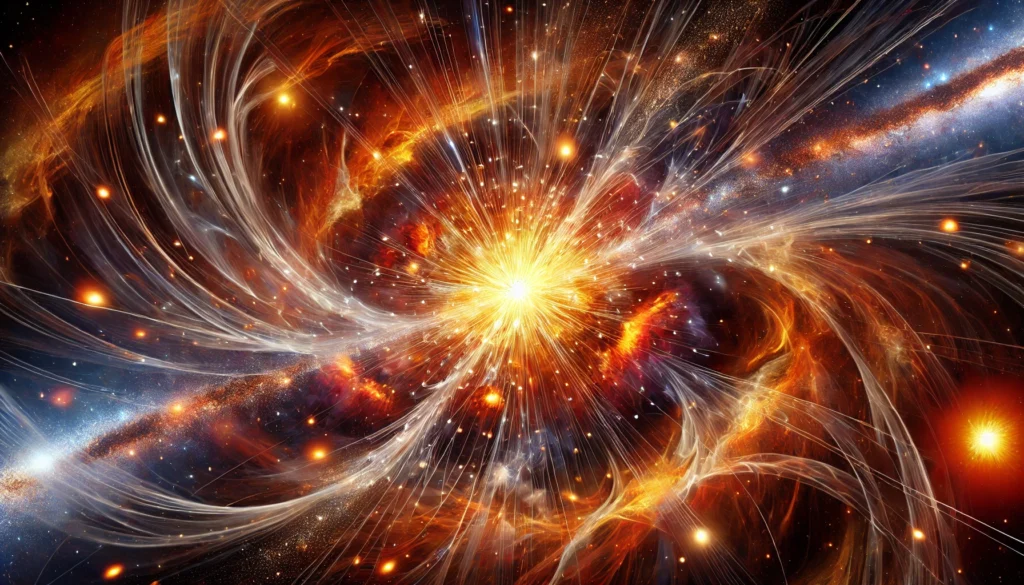When we think about the universe’s building blocks, we often consider atoms, stars, and planets. But hidden in the fabric of the cosmos, tiny particles called neutrinos quietly influence the universe in ways we are only beginning to understand. In this blog, “Role of Neutrinos in Shaping the Universe,” we will explore these elusive particles, their significance, and how they shape the very essence of our reality.
Neutrinos are subatomic particles, smaller than atoms, that interact with matter so weakly that trillions pass through your body every second without you even noticing. Despite their ghostly nature, they hold the key to understanding many fundamental questions about the universe. Let’s dive into the mysterious world of neutrinos and discover their role in the grand cosmic dance.
What Are Neutrinos?
Neutrinos are elementary particles, which means they are not made up of smaller components. They belong to a family of particles called leptons, including electrons. Neutrinos are unique because they have no electric charge and an incredibly tiny mass, much smaller than that of electrons. This lack of charge and minuscule mass allows them to slip through matter almost undetected, earning them the nickname “ghost particles.”
There are three types of neutrinos, each associated with a different lepton: electron neutrinos, muon neutrinos, and tau neutrinos. These types can transform into one another through a process called “neutrino oscillation,” which has fascinated scientists since its discovery.
The Birth of Neutrinos
Neutrinos are born in some of the universe’s most energetic and violent processes. They are produced in nuclear reactions, such as those that power the sun, during supernova explosions, and even in the radioactive decay of elements on Earth.
For example, when a star like our sun fuses hydrogen into helium in its core, it releases energy through light and neutrinos. These solar neutrinos travel from the sun to Earth in just over eight minutes, providing valuable information about the nuclear processes occurring deep within stars.
Similarly, an enormous number of neutrinos are released during a supernova—a massive explosion marking the death of a star. These neutrinos carry away about 99% of the energy produced in the explosion, making them critical players.

Neutrinos and the Early Universe
Neutrinos were also present in the early universe, moments after the Big Bang. Neutrinos were instrumental in influencing the development of the cosmos. In the initial moments following the Big Bang, the universe was a seething, dense mixture of particles, neutrinos among them. As the universe began to expand and cool, these particles started interacting with one another, eventually leading to the formation of atoms and, later, galaxies, stars, and planets.
Neutrinos helped regulate the cooling process of the early universe. Their interactions influenced the distribution of matter, contributing to the formation of large-scale structures like galaxies and clusters of galaxies. Without neutrinos, the universe as we know it might look very different today.
Neutrinos and Dark Matter
One of the most intriguing mysteries in modern physics is the nature of dark matter. This invisible substance makes up about 27% of the universe’s mass. While dark matter does not emit, absorb, or reflect light, its presence is inferred from its gravitational effects on visible matter.
Neutrinos have been considered potential candidates for dark matter. However, their extremely low mass and high speed make them unlikely to account for all dark matter. Instead, scientists hypothesize the existence of other, heavier particles, known as “sterile neutrinos,” could be responsible for dark matter. These hypothetical particles would interact even less with ordinary matter than regular neutrinos, making them even harder to detect.
Neutrinos and the Search for New Physics
The study of neutrinos has opened up new avenues for understanding physics beyond the Standard Model, which currently describes the fundamental forces and particles in the universe. Neutrinos challenge the Standard Model because they have mass, albeit tiny, while the model originally predicted them to be massless.
This discovery has led scientists to explore new theories and models that could explain the origins of neutrino mass and their role in the universe. Experiments like the Deep Underground Neutrino Experiment (DUNE) and the IceCube Neutrino Observatory in Antarctica are at the forefront of this research, searching for signs of new physics that could revolutionize our understanding of the cosmos.
The Impact of Neutrinos on Earth
On Earth, neutrinos are not just cosmic curiosities; they also have practical implications. For instance, neutrinos can provide insights into our planet’s inner workings. Geoneutrinos, produced by radioactive decay in Earth’s mantle and crust, help scientists study the heat generated within the Earth, which drives processes like plate tectonics and volcanic activity.
Moreover, neutrinos are used in nuclear reactors to monitor their operations. Since neutrinos are produced during nuclear fission, they can be detected and used to ensure the reactor functions correctly, providing a non-intrusive way to safeguard nuclear power plants.
Neutrinos in Everyday Life
While neutrinos may seem abstract, esoteric particles, they have a surprising connection to our daily lives. For example, neutrinos form elements in stars, including those that make up the matter in our bodies. The carbon, oxygen, and other essential elements to life were forged in stars, with neutrinos influencing these nuclear processes.
Additionally, neutrinos are being studied for their potential use in communication. Unlike radio waves, which can be blocked by obstacles like mountains or buildings, neutrinos can pass through almost anything. This property could one day lead to the development of communication systems that can transmit signals through the Earth, revolutionizing fields like deep-sea communication and underground exploration.
Conclusion
Neutrinos, the tiny ghost particles of the universe, hold immense power and potential. From their role in the birth of stars and galaxies to their contributions to new physics, neutrinos are fundamental to our understanding of the cosmos. As we continue to study these elusive particles, we may uncover new insights that could change how we see the universe and our place within it.
So, the next time you look up at the stars, remember that trillions of neutrinos are passing through you, carrying the secrets of the universe with them. The role of neutrinos in the universe is not just a scientific curiosity—it’s a testament to the incredible, unseen forces that shape our world and our understanding of the cosmos.
Author’s Note
Delving into the universe’s mysteries by studying neutrinos has been an enlightening experience. These tiny particles remind us how much there is yet to learn about the cosmos. This blog has sparked your curiosity and inspired you to dive deeper into the fascinating world of particle physics.
G.C., Ecosociosphere contributor.





Comments
Uau, layout incrível do blog Há quanto tempo você bloga, você fez o blog parecer fácil A aparência geral do seu site é magnífica, assim como o conteúdo
Author
obrigado cara, eu agradeço